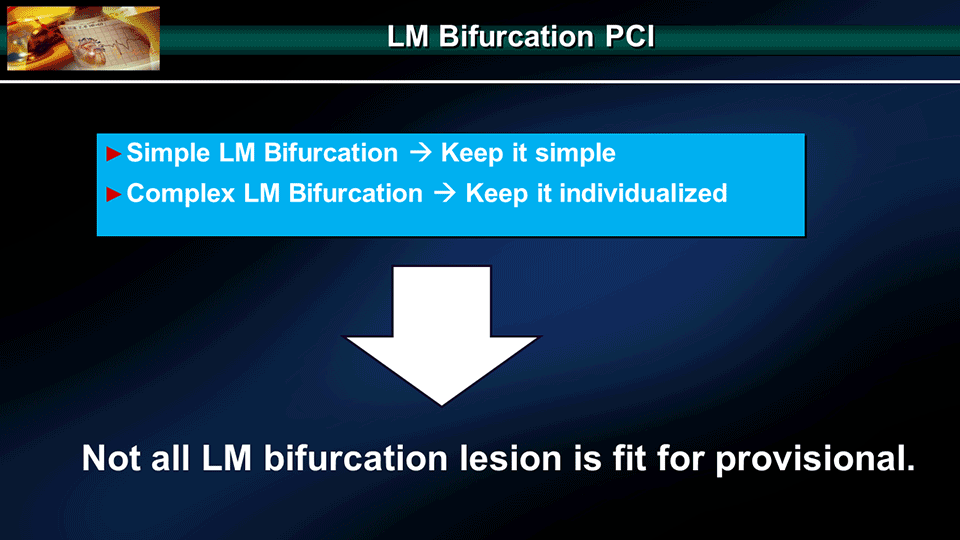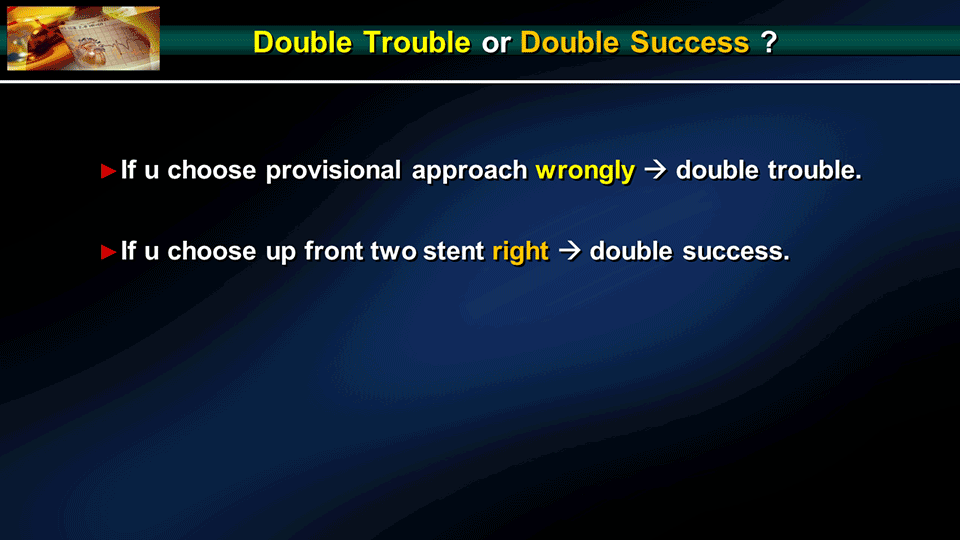News | COMPLEX PCI 2023
Double Trouble or Double Success?
Upfront 2-Stent PCI for LM
Explores the Challenges and Successes of Upfront Stenting

Lam Ho
Tuen Mun Hospital, Hong Kong, China
Dr. Lam Ho of Tuen Mun Hospital, Hong Kong, China, delved into the intricate world of percutaneous coronary intervention (PCI) for Left Main (LM) coronary artery bifurcation, providing a comprehensive exploration of the challenges and strategies inherent in this critical aspect of interventional cardiology.
Emphasizing the nuanced nature of LM bifurcation PCI, he distinguished between simple and complex bifurcations. Dr. Lam stressed the importance of tailoring the approach to the specific characteristics of the lesion, advocating for a straightforward strategy in simple cases and a more individualized approach for complex bifurcations.

Decision-Making Dilemma: Provisional vs. Upfront 2-Stent
The heart of Dr. Lam's presentation focused on the pivotal decision-making process between provisional and upfront 2-stent strategies. He vividly illustrated the risks associated with the provisional approach, particularly the closure of the left circumflex artery (LCX), emphasizing the potential for severe consequences. Incorrectly selecting a provisional approach, according to Dr. Lam, could lead to what he termed "double trouble," involving complications like the stressful wiring of LCX and increased stent thrombosis rates.
Double Trouble: The Pitfalls of Wrongly Choosing Provisional
Dr. Lam Ho highlights the potential pitfalls if the provisional approach is incorrectly chosen. Closure of the vessel and the stressful process of wiring under challenging conditions are described. The presentation emphasizes the stressful nature of such procedures, requiring experienced operators to handle critical situations.
Double Success: Benefits of Choosing Upfront Stenting Correctly
Conversely, Dr. Lam outlined the advantages associated with correctly selecting and performing upfront 2-stent implantation, which he referred to as "double success." This approach, he highlighted, offers experiential learning opportunities in wiring, stenting, and imaging, along with cost reductions due to shorter cath lab times and decreased need for extended care.
Dr. Lam also presented compelling data on stent thrombosis rates, showcasing the significantly lower incidence with upfront 2-stent procedures compared to provisional approaches that later required conversion to two stents. The lecture highlighted a 0.4% vs. 4.1% rate in definite or probable stent thrombosis over three years between the two methods.

Reducing Costs and Achieving Full Revascularization: The Triple Success
The lecture concluded with a strong emphasis on the pivotal role of operator experience and the ability to achieve full revascularization with a low residual SYNTAX score in Left Main PCI. Dr. Lam's insights and data-driven approach contribute invaluable knowledge to the evolving landscape of LM bifurcation PCI, providing a comprehensive guide for interventional cardiologists navigating this intricate terrain.
In summary, the choice between "Double Trouble or Double Success" in LM PCI is a spectrum that depends on patient characteristics, lesion complexity, and operator expertise. Dr. Lam Ho suggests that, in general, the prognosis is largely determined by the severity of the LM lesion, making the correct decision pivotal for successful outcomes.
Edited by

Ju Hyeon Kim, MD
Asan Medical Center, Korea (Republic of)

KyungAe Kim, RN
CardioVascular Research Foundation (CVRF), Korea (Republic of)

Lam Ho
Tuen Mun Hospital, Hong Kong, China
Dr. Lam Ho of Tuen Mun Hospital, Hong Kong, China, delved into the intricate world of percutaneous coronary intervention (PCI) for Left Main (LM) coronary artery bifurcation, providing a comprehensive exploration of the challenges and strategies inherent in this critical aspect of interventional cardiology.
Emphasizing the nuanced nature of LM bifurcation PCI, he distinguished between simple and complex bifurcations. Dr. Lam stressed the importance of tailoring the approach to the specific characteristics of the lesion, advocating for a straightforward strategy in simple cases and a more individualized approach for complex bifurcations.

Decision-Making Dilemma: Provisional vs. Upfront 2-Stent
The heart of Dr. Lam's presentation focused on the pivotal decision-making process between provisional and upfront 2-stent strategies. He vividly illustrated the risks associated with the provisional approach, particularly the closure of the left circumflex artery (LCX), emphasizing the potential for severe consequences. Incorrectly selecting a provisional approach, according to Dr. Lam, could lead to what he termed "double trouble," involving complications like the stressful wiring of LCX and increased stent thrombosis rates.
Double Trouble: The Pitfalls of Wrongly Choosing Provisional
Dr. Lam Ho highlights the potential pitfalls if the provisional approach is incorrectly chosen. Closure of the vessel and the stressful process of wiring under challenging conditions are described. The presentation emphasizes the stressful nature of such procedures, requiring experienced operators to handle critical situations.
Double Success: Benefits of Choosing Upfront Stenting Correctly
Conversely, Dr. Lam outlined the advantages associated with correctly selecting and performing upfront 2-stent implantation, which he referred to as "double success." This approach, he highlighted, offers experiential learning opportunities in wiring, stenting, and imaging, along with cost reductions due to shorter cath lab times and decreased need for extended care.
Dr. Lam also presented compelling data on stent thrombosis rates, showcasing the significantly lower incidence with upfront 2-stent procedures compared to provisional approaches that later required conversion to two stents. The lecture highlighted a 0.4% vs. 4.1% rate in definite or probable stent thrombosis over three years between the two methods.

Reducing Costs and Achieving Full Revascularization: The Triple Success
The lecture concluded with a strong emphasis on the pivotal role of operator experience and the ability to achieve full revascularization with a low residual SYNTAX score in Left Main PCI. Dr. Lam's insights and data-driven approach contribute invaluable knowledge to the evolving landscape of LM bifurcation PCI, providing a comprehensive guide for interventional cardiologists navigating this intricate terrain.
In summary, the choice between "Double Trouble or Double Success" in LM PCI is a spectrum that depends on patient characteristics, lesion complexity, and operator expertise. Dr. Lam Ho suggests that, in general, the prognosis is largely determined by the severity of the LM lesion, making the correct decision pivotal for successful outcomes.
Edited by

Ju Hyeon Kim, MD
Asan Medical Center, Korea (Republic of)

KyungAe Kim, RN
CardioVascular Research Foundation (CVRF), Korea (Republic of)

Leave a comment